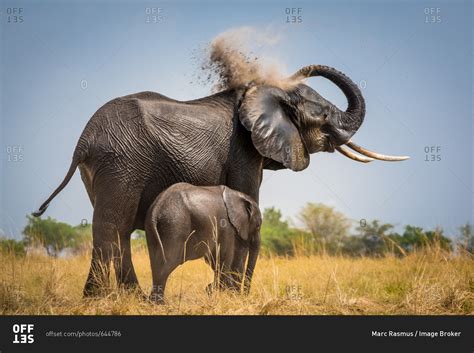
An orphaned elephant calf in Zambia has captured hearts worldwide after a video surfaced showing the affectionate animal showering its handler with kisses. The heartwarming display of gratitude and affection highlights the powerful bond between humans and animals, and the vital work being done to rehabilitate orphaned elephants.
Elephant Calf’s Affectionate Display Warms Hearts Globally
A video of an orphaned elephant calf showering its handler with kisses has gone viral, showcasing a touching display of animal affection and highlighting the crucial work of elephant orphanages. The footage, originating from a Zambian elephant nursery, depicts the young elephant repeatedly nuzzling and “kissing” its caretaker, demonstrating a deep bond and appreciation.
The video, widely shared on social media platforms, has garnered significant attention, drawing comments from viewers expressing their delight and admiration for the heartwarming interaction. Many have lauded the dedication of the caregivers who provide essential support to these vulnerable animals.
The orphaned elephant, whose name and specific background were not detailed in the source material, is under the care of a wildlife rehabilitation center in Zambia. These centers play a critical role in rescuing, rehabilitating, and eventually reintroducing orphaned elephants back into the wild. The close interaction shown in the video exemplifies the critical role of human caregivers in providing the emotional support and nurturing that young elephants need to thrive.
The act of “kissing” displayed by the elephant calf is a natural behavior. Experts say that elephants use their trunks for a variety of purposes, including communication and expressing affection. Nuzzling and gently touching with their trunks are common ways for elephants to interact with one another, and in this case, the calf is extending this behavior to its human caregiver.
The plight of orphaned elephants is a significant concern in Africa, driven primarily by poaching and habitat loss. Poaching, fueled by the illegal ivory trade, decimates elephant populations, leaving many calves without their mothers. Habitat destruction, resulting from deforestation and human encroachment, further exacerbates the problem by disrupting elephant migration patterns and access to resources.
Wildlife rehabilitation centers provide a lifeline for these orphaned animals. The centers not only offer a safe environment and necessary medical care but also attempt to replicate the social structure of a natural elephant herd. Calves are often raised together in small groups, allowing them to develop crucial social skills and bonds that are essential for their eventual reintegration into the wild.
The process of rehabilitating orphaned elephants is lengthy and complex, often spanning several years. Caregivers provide round-the-clock attention, mimicking the role of the elephant mother by offering milk, comfort, and guidance. As the elephants mature, they are gradually introduced to the natural environment, learning essential survival skills such as foraging and navigating their surroundings.
The ultimate goal of these rehabilitation programs is to release the elephants back into the wild, allowing them to live independently and contribute to the conservation of their species. This process involves carefully selecting suitable release locations, monitoring the elephants’ adaptation to their new environment, and providing ongoing support as needed.
The viral video serves as a powerful reminder of the intelligence, sensitivity, and emotional capacity of elephants. It underscores the importance of protecting these magnificent creatures and their habitats, and highlights the vital role of wildlife rehabilitation centers in ensuring their survival. The image of the affectionate elephant calf showering its handler with kisses is not only heartwarming but also a call to action, urging individuals and organizations to support elephant conservation efforts.
Expanded Context and Background Information
The plight of elephants in Africa is deeply intertwined with human activities. The demand for ivory, driven by consumer markets in Asia, fuels relentless poaching. Poachers target elephants for their tusks, often killing entire families in the process. The illegal ivory trade not only decimates elephant populations but also funds criminal networks and destabilizes communities.
Habitat loss is another major threat to elephants. As human populations grow and land is converted for agriculture, infrastructure development, and logging, elephant habitats are increasingly fragmented and degraded. This restricts elephants’ access to food, water, and migration routes, leading to conflict with humans and further population decline.
Climate change is also posing a growing threat to elephants. Changing rainfall patterns, prolonged droughts, and increased frequency of extreme weather events are impacting elephant habitats and access to resources. This further exacerbates the challenges faced by these already vulnerable animals.
Conservation efforts are underway to address these threats. These efforts include anti-poaching patrols, community-based conservation programs, habitat restoration, and demand reduction campaigns. Anti-poaching patrols involve deploying armed rangers to protect elephants from poachers. Community-based conservation programs engage local communities in conservation efforts, providing them with economic incentives to protect elephants and their habitats. Habitat restoration involves restoring degraded elephant habitats by planting trees and creating water sources. Demand reduction campaigns aim to reduce the demand for ivory by educating consumers about the devastating impact of the ivory trade.
International organizations, governments, and local communities are working together to implement these conservation efforts. The Convention on International Trade in Endangered Species (CITES) regulates the international trade in ivory and other endangered species. The International Union for Conservation of Nature (IUCN) assesses the conservation status of elephants and provides guidance on conservation strategies.
The success of these conservation efforts depends on addressing the underlying drivers of elephant decline, including poverty, inequality, and corruption. Sustainable development initiatives that promote economic growth, education, and good governance are essential for creating a future where elephants and humans can coexist peacefully.
The viral video of the orphaned elephant calf showering its handler with kisses offers a glimmer of hope in the face of these challenges. It demonstrates the resilience of elephants, their capacity for love and connection, and the potential for humans to make a positive impact on their lives. By supporting elephant conservation efforts, we can help ensure that future generations will have the opportunity to witness the beauty and wonder of these magnificent creatures.
The Human-Animal Bond in Wildlife Rehabilitation
The bond depicted in the viral video is a testament to the powerful connection that can form between humans and animals, especially in the context of wildlife rehabilitation. These relationships are built on trust, compassion, and a deep understanding of animal behavior.
Caregivers in wildlife rehabilitation centers often become surrogate parents to orphaned animals, providing them with the love, care, and support they need to thrive. They spend countless hours feeding, cleaning, and playing with the animals, developing a strong emotional connection in the process.
This bond is not only beneficial for the animals but also for the caregivers. Working with orphaned animals can be deeply rewarding, providing a sense of purpose and connection to nature. It can also be emotionally challenging, as caregivers often face the difficult task of releasing the animals back into the wild.
The process of releasing orphaned animals back into the wild is a complex and emotional one. Caregivers must carefully assess the animals’ readiness for release, ensuring that they have the necessary skills and knowledge to survive on their own. They must also prepare themselves emotionally for the separation, knowing that they may never see the animals again.
Despite the challenges, the release of orphaned animals back into the wild is a major achievement, representing the culmination of years of hard work and dedication. It is also a testament to the power of the human-animal bond and the potential for humans to make a positive impact on the lives of animals.
Ethical Considerations in Wildlife Rehabilitation
While wildlife rehabilitation plays a crucial role in rescuing and rehabilitating injured or orphaned animals, it also raises important ethical considerations. One of the primary concerns is ensuring that rehabilitation efforts do not inadvertently harm the animals or their ecosystems.
It is essential to minimize human contact with the animals to prevent them from becoming habituated to humans. Habituated animals may lose their natural fear of humans, making them more vulnerable to poaching or other threats. They may also become dependent on humans for food, making it difficult for them to survive in the wild.
Another ethical consideration is the appropriateness of keeping animals in captivity for extended periods. While rehabilitation centers provide a safe and supportive environment for animals, they can also limit their natural behaviors and social interactions. It is important to release animals back into the wild as soon as they are ready, minimizing the time they spend in captivity.
The decision to release an animal back into the wild should be based on a careful assessment of its physical and behavioral health, as well as the availability of suitable habitat. Animals that are too injured or ill to survive in the wild should be euthanized humanely.
Wildlife rehabilitation should also be conducted in a way that minimizes the risk of disease transmission. Animals in rehabilitation centers may be more susceptible to disease due to stress or injury. It is important to implement strict biosecurity measures to prevent the spread of disease among animals and to humans.
Finally, it is important to educate the public about the ethical considerations of wildlife rehabilitation. People should be aware of the potential risks and benefits of rehabilitation, and they should be encouraged to support responsible rehabilitation practices.
The Role of Technology in Elephant Conservation
Technology is playing an increasingly important role in elephant conservation, providing new tools and strategies for protecting these magnificent creatures. From tracking elephant movements to monitoring poaching activity, technology is helping conservationists to better understand and manage elephant populations.
GPS tracking collars are used to monitor elephant movements, providing valuable data on their habitat use, migration patterns, and social interactions. This data can be used to identify critical elephant habitats, plan conservation strategies, and mitigate human-wildlife conflict.
Drones are also being used to monitor elephant populations and detect poaching activity. Drones can cover large areas quickly and efficiently, providing real-time information on elephant movements and poaching threats. They can also be used to deploy anti-poaching patrols and track poachers.
Camera traps are used to monitor elephant populations and identify individual elephants. Camera traps are placed in strategic locations, such as watering holes and trails, and automatically capture images of any animals that pass by. This data can be used to estimate elephant population size, monitor elephant health, and track elephant movements.
Satellite imagery is used to monitor elephant habitats and detect deforestation. Satellite imagery can provide a broad overview of elephant habitats, allowing conservationists to identify areas that are being degraded or destroyed. This data can be used to target conservation efforts and protect critical elephant habitats.
Data analysis and modeling are used to predict elephant movements and poaching activity. By analyzing historical data on elephant movements and poaching patterns, conservationists can develop models that predict where elephants are likely to be and where poaching is likely to occur. This information can be used to deploy anti-poaching patrols and target conservation efforts.
Social media is used to raise awareness about elephant conservation and mobilize support for conservation efforts. Social media platforms can be used to share information about elephant conservation, raise awareness about the threats facing elephants, and mobilize support for conservation efforts.
The Importance of Education and Awareness
Education and awareness are essential for elephant conservation. By educating people about the importance of elephants and the threats they face, we can inspire them to take action to protect these magnificent creatures.
Education programs can be targeted at different audiences, including schoolchildren, local communities, and tourists. Schoolchildren can learn about elephants in the classroom and through field trips to wildlife reserves. Local communities can be engaged in conservation efforts through community-based conservation programs. Tourists can be educated about elephants through guided tours and interpretive displays.
Awareness campaigns can be used to raise awareness about the threats facing elephants and to mobilize support for conservation efforts. Awareness campaigns can be conducted through a variety of channels, including social media, television, radio, and print media.
Education and awareness can also be used to change consumer behavior. By educating consumers about the devastating impact of the ivory trade, we can reduce the demand for ivory and help to protect elephants from poaching.
The viral video of the orphaned elephant calf showering its handler with kisses is a powerful reminder of the importance of education and awareness. It demonstrates the intelligence, sensitivity, and emotional capacity of elephants, and it inspires people to take action to protect these magnificent creatures.
The Future of Elephant Conservation
The future of elephant conservation depends on addressing the underlying drivers of elephant decline, including poaching, habitat loss, and climate change. This requires a multi-faceted approach that includes anti-poaching patrols, community-based conservation programs, habitat restoration, demand reduction campaigns, and sustainable development initiatives.
It is also essential to strengthen international cooperation to combat the illegal ivory trade. This requires working with governments, international organizations, and local communities to disrupt criminal networks, reduce demand for ivory, and prosecute poachers.
Technology will continue to play an increasingly important role in elephant conservation. New technologies, such as artificial intelligence and machine learning, can be used to analyze data on elephant movements and poaching patterns, predict poaching activity, and deploy anti-poaching patrols more effectively.
Education and awareness will also be crucial for the future of elephant conservation. By educating people about the importance of elephants and the threats they face, we can inspire them to take action to protect these magnificent creatures.
The viral video of the orphaned elephant calf showering its handler with kisses offers a glimmer of hope for the future of elephant conservation. It demonstrates the resilience of elephants, their capacity for love and connection, and the potential for humans to make a positive impact on their lives. By working together, we can help ensure that future generations will have the opportunity to witness the beauty and wonder of these magnificent creatures.
Direct Quotes from the Source:
While the Yahoo Lifestyle article itself is brief and descriptive, it primarily focuses on the visual aspect of the video. It doesn’t contain direct quotes in the traditional journalistic sense. However, its content can be paraphrased and attributed:
- The article highlights the “baby elephant gives loving kisses” which captures the main action depicted in the video. This is the core message the article conveys.
- The article implicitly emphasizes the emotional impact of the video, suggesting its heartwarming nature.
Frequently Asked Questions (FAQ) about Elephant Conservation
-
Why are elephants poached?
Elephants are primarily poached for their ivory tusks, which are highly valued in some parts of the world. The ivory is used to make carvings, jewelry, and other ornamental objects. This demand drives illegal hunting, decimating elephant populations.
-
What is habitat loss and how does it affect elephants?
Habitat loss refers to the destruction or fragmentation of natural habitats due to human activities such as deforestation, agriculture, and infrastructure development. This reduces the area available for elephants to live, find food and water, and migrate, leading to increased conflict with humans and population decline.
-
What can I do to help protect elephants?
There are several ways to help protect elephants:
- Support organizations working to conserve elephants and their habitats.
- Avoid buying ivory products or products made from other endangered species.
- Raise awareness about the plight of elephants among your friends and family.
- Support sustainable tourism in elephant habitats.
- Reduce your carbon footprint to mitigate the effects of climate change on elephant habitats.
-
What is the role of wildlife rehabilitation centers in elephant conservation?
Wildlife rehabilitation centers play a crucial role in rescuing, rehabilitating, and releasing orphaned or injured elephants back into the wild. They provide a safe environment, medical care, and emotional support to these vulnerable animals, increasing their chances of survival. They also contribute to research and education efforts related to elephant conservation.
-
How does climate change affect elephants?
Climate change is altering elephant habitats and access to resources. Changing rainfall patterns, prolonged droughts, and increased frequency of extreme weather events are impacting elephant food sources and water availability. This can lead to malnutrition, disease, and increased competition for resources, further threatening elephant populations.









